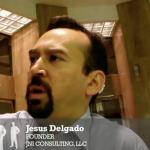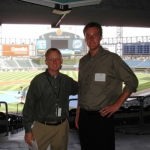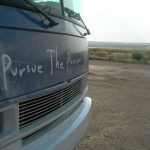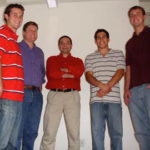Rick Farmiloe draws for a living. He has worked on films for Disney and Dreamworks. He has truly pursued his animation passion since deciding that he wanted to draw at age 9.
Under the mentorship of this animator, he started to really work at drawing by going to the park or the zoo everyday, and just drew what he saw. He then applied to Disney in 1982, and was hired as an assistant to the movie the movie Black Cauldron, where he learned from his mentor about the ins and outs of movie making.
Through his hard work, he eventually moved up to animator in the movie The Great Mouse Detective. From there he worked on Oliver and Company, drew Scuttle from The Little Mermaid, Abu from Aladdin, Le Fou from Beauty and The Beast, and Puffin from The Swan Princess. He has also worked on the storyboards of Shrek and the Rugrats movie. He has worked on the T.V. series Camp Lazlo and is currently working on the new Simpsons movie.
 In the interview, we asked him about obstacles to overcome in the industry and advice to students interested in drawing animation for a living. Here is what we came up with:
In the interview, we asked him about obstacles to overcome in the industry and advice to students interested in drawing animation for a living. Here is what we came up with:
What is the biggest obstacle you have overcome?
“The biggest obstacle I overcame was probably self doubt. There were times where I was in a room with people that could outdraw me, or when I was doubting my talent, and that was overcome with persistence. Persistence, and drawing until you’re good enough allowed by to gain confidence. That, and having success, and taking that success with you to improve your confidence.”
What would be your advice to students wanting to get into the animation industry?
“Learn to eat Top Ramen. No seriously, if you want it bad enough, you can do it. You have to deal with failure, and a lot of artists are very sensitive to this. But if you are persistent and work hard, you can overcome failure.”
“The animation industry is hard to break into, but if you excel in school that may be enough to get you in. A lot of the people here were hired right out of school because their talent was recognized in class and their talent was too much too pass up.”
Interview
When I was 9 years old I knew I wanted to do this. I knew I either wanted to do drawing cartoons like Charles Schultz did, or be an animator. But I couldn’t come up with something funny every day. How do people do that? So I decided to be an animator at 9 years old. Everything I did went towards that.
My mom would be like, ‘Why don’t you come out of your room and come be social?’ They’d have all these people over. I’d just shut the door and draw and be perfectly happy. I mean, I had lots of friends. I was very social in high school and played sports and stuff. But I liked being by myself.
I got out of high school and went to the JC for a couple years and went to art school in Oakland. Then I just moved down here because I wanted to be an animator.
I got this two bit job working at this friggin’ record store and moved down here with absolutely no prospects at all thinking I’d figure it out from there. I knew enough where I could get some kind of job in animation to start.
Anyways, I got hired at Filmation and started animating right away. After awhile, the tv stuff is really boring. You have to do it really fast and you can’t get good stuff. So I started working on my portfolio to try and get into Disney. This guy said it was going to take me three or four tries to get into Disney, because they weren’t going to accept me the first time I apply.
I said, ok, whatever. And I did a bunch of drawings for months. I’d go to the park every day, or the zoo. Every day. I’d just draw, draw, draw whatever I saw. Anyway I applied at Disney, and they called me back and asked if I wanted to work on this movie called the Black Caldron. I’m like, ‘Whoa.’ I didn’t expect to start right away, but I was like, yeah sure.
So I started working at Disney pretty much right away. But I was an assistant. I wasn’t an animator. I didn’t have enough experience. I had a really good animator to work with and learned a lot of stuff from him.
Then I became an animator on the Great Mouse Detective. I was there for all those years from ’82-’92. Worked on Oliver and Company. When Little Mermaid hit, that was this huge boom. Before that, I didn’t know if we were going to be around. Because Disney had new ownership, so we didn’t know what was going to happen.
Great Mouse Detective came out and did well. Oliver and Company came out and did a little better. Then Little Mermaid came out, and it was this huge giant hit. On Little Mermaid I animated Scuttle, the seagull.
It was fun because all those years I would come up with these gags and stuff. I feel like I’m bragging, but I’m just telling you what happened. I would come up with gags and stuff and this Scuttle thing with the fork in the hair. The way that was storyboarded, and I don’t even know if you remember it, but the storyboard had him with a fork. Ariel asked him what the fork was for and he said humans use them to do their hair. And he’d stick the fork in his hair and kind of teased it and made it puffy. That was about it.
I said, “Why don’t we something with the fork? Maybe it’s like he’s swirling spaghetti or something. That’s how it turned out.
I’ll tell you another story. I was on Rescue Down Under and there was a scene where the albatross was landing on the roof and they stretch this bra across to stop him. Again, the storyboard had it so he hits the bra, he gets up, does his dialogue and that’s it.
I said, ‘We got this bra…let’s do something with the bra!’ I went to the director and said, ‘How about when the bird hits the bra, he tumbles and you don’t see anything. He gets up, and he’s wearing the bra!’ The director is like, ‘No way are we going to do that. That’s really bad taste.’ I said, ‘Well let me just animate it, and if you think it’s bad taste, then we won’t do it.’ It wasn’t a big thing really. He just gets up and he’s wearing it.
So anyway I animated it and the director said it looked like it was going to be alright. And then they had this screening for a bunch of kids or whatever the week after we finished it. The review cards from the kids came back, and that scene with the bird and the bra got the biggest laugh in the whole movie.
I’m telling you that because as an animator, you have to come up with ideas. You don’t just sit here and animate the way it’s laid out and that’s it. If you have a better idea to make it funnier, then you do that. You come with ideas also. You don’t just dig in like this is an assignment. You have to think about what the most entertaining way to get this across.
The farthest thing I ever did was putting my kids in a scene. No dildos on the box of Little Mermaid for me. If there’s a scene with four or five kids in the background, and they’re miscellaneous and not important, I’ll just put my kids in there. That kind of stuff.
In this movie the First Rescuers there’s this scene where the albatross jumps off a building in New York City and there’s all these windows flying by. Well somebody in the background put a picture of a girl topless in one of the windows. It’s only on there for like two frames, but when you stop it frame by frame, you’ll see it as the albatross is falling. It’s like a real picture of a girl from a magazine who is topless.
There’s no way you’d no it if you’re watching it at full speed. When they released the video, all the parents got really upset and they pulled the videos really fast and blacked it out. So now you’ll never see it. But if you have the earlier versions of it, it’s in there.
I did Scuttle in Little Mermaid, Lafu in Beauty and the Beast, and then I did Abu in Aladdin. I kind of modeled Abu after my son when he was four years old. He was always getting in trouble and kind of mischievous. Some of my scenes of Abu were modeled after my son because he was always mischievous and getting into trouble and stuff. Just his attitude and his facial expressions. People who knew my son would say, ‘Hey, that’s something that Grant would do!’ That’s exactly what I was thinking.
After Disney I went and did a movie called Swan Princess. If you haven’t seen it, don’t worry about seeing it. I did Puffin there. And then I went to Dreamworks for like 5 years. I was an animator there and then went into storyboarding because I had all these story ideas. Jeffrey Katzenberg was like, ‘You’ve got all these ideas…you should think about getting into story.’ After awhile I was tired of animating so I worked on storyboards for Shrek. Then I left there and did the Rugrats movie, and then did some TV for awhile.
I did Camp Lazlo. I was the storyboard director on that for awhile, and then I got called to do some animation again for the Simpsons movie. It’s kind of rare now to do the regular hand drawn animation. But you have to do what you have to do survive.
Looking back, I think my movies that I did at Disney were my best. I think my actual best animation was Swan Princess. Hardly anyone saw it. But I was the head of a character on that and my animation was the best on that character. But you compare that to Little Mermaid, Beauty and the Beast, and Aladdin…I just think the fact that I worked on those movies. At the time we were doing it we weren’t making classics, we were just thinking we were working on these movies. But now you look back and people look at that as a really great period of time when the movies were all great and Disney made tons of dough. They were never able to recapture that after awhile.
Just the fact that I was there at a really good time at Disney. It’s not anything personal, like look what I did, but more of the fact that I was part of the team thing. If you’re playing basketball, you’re a part of a team. They don’t just give out one ring. The whole team gets them.
To be part of Disney at that time…when I started at Disney it was a depressing place. Black Caldron was crap and there were all these old guys in there that weren’t interested in making new films. Tim Burton was there at the time. Tim wanted to do all this really cool stuff and the old guys were like, ‘You don’t know how to draw.’ They stuck him a corner somewhere. They weren’t appreciating all these ideas.
To go from that to what happened was cool because when it got really good, it was really exciting. Being part of that and seeing it turn around was really cool.
Another thing that’s cool is when I was doing the Little Mermaid and stuff, moms would walk up to me with their five year old kids with their Ariel t-shirts on and tell me their daughter loved the movie and Scuttle was their favorite character. That was all cool.
But now I’m working with these people. These kids who were watching these things when they were little, I’m now working with them. ‘Oh my God, you worked on that!?’ They were like six when they watched them, which makes me feel old. But it’s cool that they remembered that and it made them want to do this. So it’s cool because I’m now working with people who were little kids when those things came out.
Every job I’ve gotten, they’ve called me. I’m pretty well known in the business. I’m not a superstar. People know me. But every job I’ve gotten is when they’ve called me. Rarely is it when I’m like, ‘Look at my stuff.’ I have gotten jobs that way, but for the most part it’s out of the blue. ‘You’re doing a what? A Simpsons movie?’ I didn’t even know they were doing one, and here I am.
I don’t like to have to audition. I’ve been doing this long enough where people know me. That’s good.
Unless there’s something that’s happening right after, I move on to something else. I tend not to move around a lot, although I have. That’s just the way it is. I’d prefer just to go back to Disney. Anyplace where I can animate, that’s what I’ll do.
The way it used to work is you just went from one film to the next at Disney. But the way the business is now, it’s by project. If Disney wants you on the next project, then you’re still there. If they don’t want you on the next project, then you’re out. That’s how it works.
I don’t really get tired of drawing during the day. I get tired of drawing when it’s not working. When my stuff isn’t working and it’s not looking good then I get sick of it. I just get up and go for a walk or whatever.
The thing I don’t do, which a lot of people do, is they’ll go home and work on their own stuff. I usually work really hard when I’m at work. I do have side projects that I’m developing, but when I get home I just want to have a martini and watch baseball.
I don’t actually get tired of drawing. When you’re working really really hard and you’re doing it for so long, you have the ‘I need to take a break kind of thing.’ But you don’t really get sick of it where you hate it. Rarely have I gotten to the point where I’m doing a scene where I hate it. Only if it’s not working. If it’s working I get excited. Then I could go further and I could go faster.
People say to me, ‘You’re so lucky. You don’t have to work for a living. You just draw! You don’t have a regular job.’ But it is a job. But I like it. That’s the difference. It is a lot of work. It’s just that we enjoy it. It’s a lot of freaking work. It’s really hard. You know? But these guys love doing it.
It’s like basketball. Michael Jordan didn’t just walk out there and play. He worked and worked and worked as good as he was. But you love doing it. That’s the difference. It’s still lots of work, but you enjoy it.
It’s hard to break in with no experience. But if you’re talented, you will get in. There’s a lot of people who come out of school and haven’t worked anywhere, but their stuff is so good that their potential will get them in. That’s how these guys get in here. It’s not like everyone is in their seventies. So obviously they’ve hired new people.
It’s a hard business to get in, and be in, and stay in. There’s lots of competition. But if you’re really good and you have something to offer, they’ll figure out a reason to bring you in.
It’s just frustrating when you’re thinking of something and you want it to look a certain way, but you just can’t quite get there. That’s really frustrating.
It depends on how long a scene is. A foot and a half is one second. You try to do, when I was at Disney, about five to ten feet of film a week. Which is a few seconds. Five feet a week is pretty good. Ten feet a week is a lot in animation. It’s just a few seconds were talking about. It’s real time consuming, which is why you need lots of people to do it.
What kind of advice would you give to a student trying to make it as an animator?
Learn to eat Top Ramen. You just have to work at it. You have to keep doing it. If you really want to do it, it’s one of those deals where no one can talk you out of it. When I was younger, my mom and dad would tell me that I had to find something else to do. It’s cool that you like to draw and that you’re good, but you’re not going to make a living at it so you better find something else to do. My dad was a business guy. My mom was a painter and an artist, so she kind of got it. My dad could not get me at all. We related to how our sports went, but when it came to animation and cartoons, he was just like, ‘You are one weird kid.’ So we’d start talking about the Giants again.
My parents were like, it’s fun to do this on the side, but find something else to do. I was like, ‘Alright. Ok.’ I didn’t know any better. But then I went to them and said, ‘You know, if I could do this, I don’t want to do anything else. I can’t think of anything else that I’d want to do. I’m not a salesman or a lawyer. I don’t want to do anything else. If I can’t be an animator or a cartoonist, I don’t know what I’ll do. I’ll just do whatever and make the most money I could make or whatever because I’m not going to be enjoying anything.’ I just couldn’t get that out of my head that animation was what I wanted to do.
The point is that if you want to do it bad enough, no one can talk you out of it. But it takes a lot of work and you have to keep at it and not get frustrated. You’re going to get rejected constantly. That’s really hard. Artists are sensitive and they take everything really personally. I mean, we take red lights personally. You just have to be persistent and not give up. Keep plugging away.
How much of an influence was Grandma Jeanne on your work?
Obviously what she did and I do are completely different. She was a painter. I got my talent from her. I think just the fact that she understood what I was trying to do. I wasn’t completely out in left field to her. Because she kind of understood me and that I liked doing different things than other kids. That helped.
And she was encouraging. As I got older and better, and she could see where it was going, she became more encouraging. My dad was really encouraging when I started working. When I got a job, he was excited. He just didn’t get it. When I started doing it, I was like, ‘I told you I was going to do this.’ He was all cool and proud of me. There’d be this stories about me up in the Press Democrat and he’d keep these stories. It was funny.
What do think the largest obstacle to overcome?
Probably just my own self doubt. Not being confident earlier on. Sometimes still you can get really intimidated by all these artists around that can outdraw me easily.
How do you overcome that?
I just figured that I have to get through it and be persistent. Just keep drawing. If you’re not good enough, just keep drawing until you are good enough. If you have a little bit of success, it encourages you. A couple little breaks here and there and someone says, ‘I love your stuff! It’s a great scene.’ Then it’s like, I’m not completely out of it. I do know what I’m doing sometimes.
That self doubt used to happen all the time and it happens now. ‘God I can’t draw. What’s the matter with me? I’ve been drawing all these years and I’m a fraud. I really can’t draw. I’ve been fooling people for this many years?’ You know.
What were you influenced by?
I was influenced by the very first Disney movies. The first movie that influenced me was the Sword and the Stone. I’ll never forget just how that looked. All these colors and characters moving around. But when I saw Pinocchio, that just turned it around. That’s what made me think that I wanted to do. I was a little kid, and I wanted to draw cartoons. I did know I wanted to be an animator. I just knew I wanted to draw cartoons.
Warner Bros was a huge influence. Bugs Bunny and all that stuff. Those two studios and the stuff they did…and Charles Schultz! The fact that Charles Schultz was in Santa Rosa. I loved Peanuts and stuff. The fact that he was there, lived there, and was doing this stuff made me see that I wasn’t completely dreaming. You can do this for a living. He was rich and successful. Not that I was as good as him, but it was proof that I could do this for a living.
I’d like to do my own film. There’s a couple things I’m trying to get going. I’ve directed some stuff before, but not a feature. But if they don’t, it’s really hard to get your own projects off the ground. As long as I keep doing this. As long as I enjoy it I’ll keep doing it. I could see myself doing it until I’m 70. But I don’t know what next year is going to look like.






